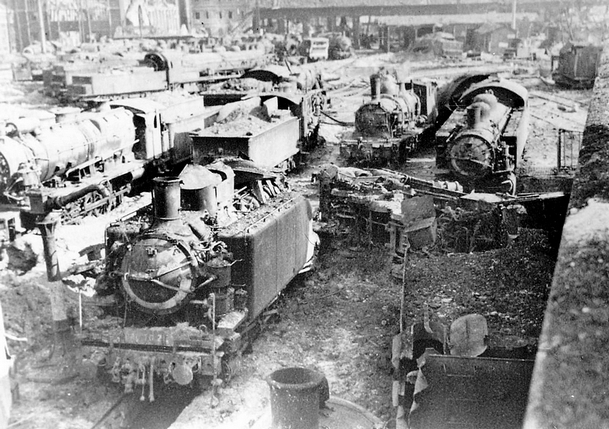You will find here a selection of documents on the theme of destruction and reconstruction, drawn from our collections:
Map of destroyed structures as of February 1, 1945.
This map indicates structures that have not been restored and structures that have been at least temporarily restored.
0026LM0033-007 (pages 120-122)
Details of the damage caused by air attacks from July 1, 1942, to February 28, 1943.
Appendix to the letter dated April 12, 1943, from the Central Equipment Service, which provides, by Region, the details of damage inflicted on rolling stock by air attacks that occurred from July 1, 1942, to February 28, 1943. This table indicates, by region, the locations affected and the nature of the attack (explosive bombs, strafing), breaks down the passenger cars and wagons that suffered repairable and irreparable damage, and provides an estimate of the damage costs.
SNCF map of the French railways illustrating the destruction of the rail network. The map is divided into four parts: 1st part: Northwest. 2nd part: Northeast. 3rd part: Southwest. 4th part: Southeast.
This map details the main stations, major sorting yards, principal depots, large carriage and wagon workshops, machine workshops, track stores, and traction stores. It uses a red cross to highlight installations that were demolished or severely damaged.
Photograph of the destruction of the passenger building at Angers station.
Angers suffered bombings in May 1944.
Letter from the President of the Board of Directors addressed to the Ministry of Public Works and Transport regarding the reconstitution of the steam locomotive fleet.
This letter reports that the locomotive fleet has been so severely damaged that repairs will occupy the SNCF’s workshops and those of the private industry working for it for several months. Apart from military-type locomotives to be supplied by the Allies, negotiations have been initiated with American and British industries, even though their locomotives do not correspond to the standardization that the SNCF had applied to its modern equipment. The SNCF requests authorization from the Minister of Public Works to proceed with the necessary orders.
“Act of War” document from the Track and Buildings Service, following destruction carried out by the Germans during their retreat, at the Troyes station (lines 40 and 57) on August 25, 1944.
Eastern Region, Track and Buildings Service, 2nd district. This handwritten form briefly lists the damaged constructions and engineering structures.
0206LM0001-001 (pages 31 à 34)
Document on the reconstruction of the Belfort depot.
This document, subtitled “When the coal miners of the Belfort depot roll up their sleeves,” reports on the events that occurred during the period 1939-1945 and discusses the practical aspects of the reconstruction of the depot, which was successively destroyed by the Allies and the Germans.

